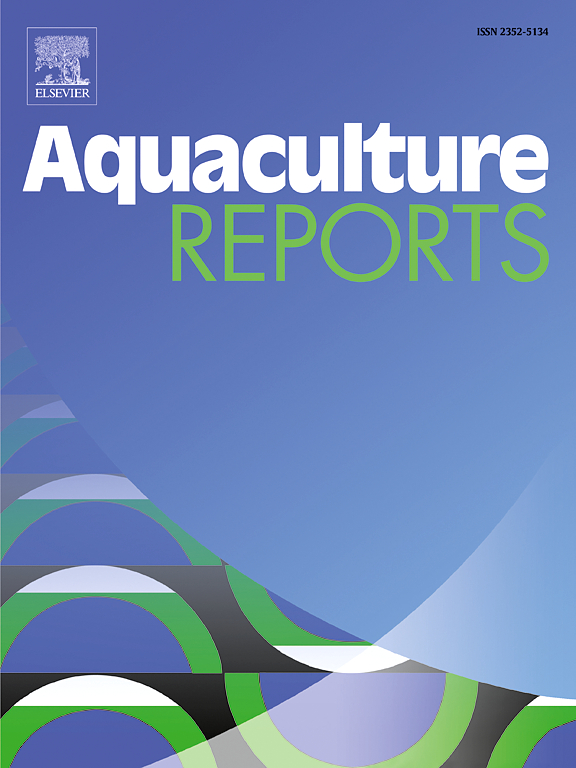巴兰濑鱼消化、肠道运输和吸收的动态模拟模型
IF 3.2
2区 农林科学
Q1 FISHERIES
引用次数: 0
摘要
巴兰濑鱼是一种广泛用于养殖大西洋鲑鱼的清洁鱼,从大自然中收集并饲养用于此目的。巴兰濑鱼养殖的主要瓶颈之一是导致高采食量、生长和健康的日粮配方。这个问题被认为与食物的可接受性差以及该物种的胃和短消化系统的功能特性有关。本研究旨在提高对消化功能的认识,为更好地配制饲料和提高综合生产性能提供依据。为此,我们建立了一个机制动态模型,量化了濑鱼对所选宏量营养素的消化、吸收和保留效率。动态模型是一种强大的工具,可以将实验中的实际数据与假设、理论概念和文献数据整合在一个迭代过程中,从而澄清和控制实验、假设和设计。由于它的机械性质,巴兰濑鱼模型可以很容易地适应其他鱼类。该模型是根据先前发表的结果进行校准的,在这些结果中,鱼被喂食添加了惰性标记物的饲料,以跟踪消化、吸收和排泄率。模型过高估计了蛋白质的消化率/吸收量(表观消化系数;ADC)在第一肠段(S1),但对其余肠段表现出良好的顺应性。模型和实验数据均表明,吸收蛋白质的ADC-P大部分位于S1区。对于脂质,S2和S3对ADC-L的贡献更大。换饲料后计算肠道转运时间为12-14 h。90 %的饲料从S1转移到中肠(S2)需要4-8 h。此时,7 %的肠道内容物已进入后肠(S4)。该模型很好地模拟了S4的转运,但低估了从球茎(S1)到前中肠(S2)的转运速率。本文章由计算机程序翻译,如有差异,请以英文原文为准。
A dynamic simulation model for digestion, gut transit, and absorption in the ballan wrasse, Labrus bergylta
Ballan wrasse is a widely used cleaner fish for farming Atlantic salmon and is collected from nature and reared for this purpose. One of the main bottlenecks in ballan wrasse rearing is formulation of diets that result in high feed intake, growth, and health. The problem is believed to be related to poor acceptability of diets and functional properties of the agastric, short digestive system of the species. The aim of this study was to improve understanding of digestive functions as basis for making better feed and improving overall production performance.
For this purpose, we developed a mechanistic dynamic model that quantifies digestion, absorption, and retention efficiency of selected macronutrients in ballan wrasse. Dynamic models are powerful tools for integrating practical data from experiments with hypotheses, theoretical concepts, and literature data in an iterative process that clarifies and controls experiments, hypotheses, and designs. Due to its mechanical nature, the ballan wrasse model can be easily adapted to other fish species.
The model was calibrated with previously published results where the fish were fed diets with added inert markers to follow digestion, absorption, and evacuation rate. The model overestimated protein digestibility/absorption (Apparent Digestibility Coefficient; ADC) in the first intestinal segment (S1) but showed good compliance for the rest of the intestine. Both the model and experimental data showed that a large fraction of protein absorption ADC-P was in S1. For lipids, both S2 and S3 contributed more to ADC-L. The gut transit time was calculated after feed change and was 12–14 h. It took 4–8 h for 90 % of the feed to move from S1 to midgut (S2). At this time, 7 % of the intestinal contents had entered the hindgut (S4). The model simulates transit of S4 well, but underestimates transfer rate from bulb (S1) to anterior midgut (S2).
求助全文
通过发布文献求助,成功后即可免费获取论文全文。
去求助
来源期刊

Aquaculture Reports
Agricultural and Biological Sciences-Animal Science and Zoology
CiteScore
5.90
自引率
8.10%
发文量
469
审稿时长
77 days
期刊介绍:
Aquaculture Reports will publish original research papers and reviews documenting outstanding science with a regional context and focus, answering the need for high quality information on novel species, systems and regions in emerging areas of aquaculture research and development, such as integrated multi-trophic aquaculture, urban aquaculture, ornamental, unfed aquaculture, offshore aquaculture and others. Papers having industry research as priority and encompassing product development research or current industry practice are encouraged.
 求助内容:
求助内容: 应助结果提醒方式:
应助结果提醒方式:


